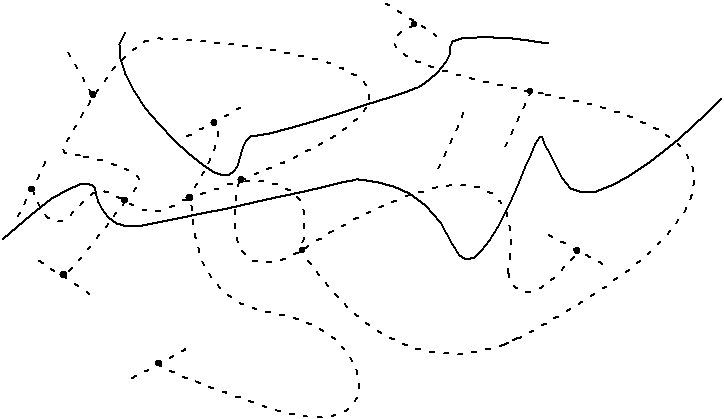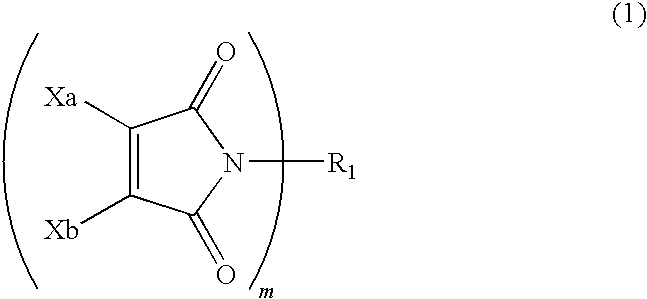Thermosetting Resin Composition of Semi-IPN Composite, and Varnish, Prepreg and Metal Clad Laminated Board Using the Same
- Summary
- Abstract
- Description
- Claims
- Application Information
AI Technical Summary
Benefits of technology
Problems solved by technology
Method used
Image
Examples
preparation example 1
[0102]To a one-liter separable flask equipped with a thermometer, a reflux condenser, a lowered pressure concentration apparatus and a stirring apparatus, 350 parts by weight of toluene and 50 parts by weight of polyphenylene ether (S202A, manufactured by Asahi Kasei Chemicals Corporation, Mn: 16,000) as the component (A) were introduced, the temperature inside the flask was set to 90° C., and the contents were dissolved while stirring. Then, 100 parts by weight of a chemically unmodified butadiene polymer (B-3000, manufactured by Nippon Soda Co., Ltd., Mn: 3000, 1,2-vinyl structure: 90%) as the component (B) and 30 parts by weight of bis(4-maleimidophenyl)methane (BMI-1000, manufactured by Daiwa Fine Chemicals Co., Ltd.) as the component (C) were introduced, and methyl isobutyl ketone (MIBK) was introduced as a solvent so that the concentration of solids (involatile fraction) in the solution was made to reach 30% by weight. The mixture was continuously stirred, and it was confirmed...
preparation example 2
[0104]A polyphenylene ether-modified butadiene prepolymer was obtained in the same manner as in Preparation Example 1, except that 30 parts by weight of polyphenylmethanemaleimide (BMI-2000, manufactured by Daiwa Fine Chemicals Co., Ltd.) was used instead of the bis(4-maleimidophenyl)methane used as the component (C) in Preparation Example 1. The conversion rate of BMI-2000 in this polyphenylene ether-modified butadiene prepolymer solution was measured using GPC. The conversion rate was 35%.
[0105]Subsequently, a resin varnish of Preparation Example 2 (solid concentration: about 40% by weight) was prepared using this solution, in the same manner as in Preparation Example 1.
preparation example 3
[0106]A polyphenylene ether-modified butadiene prepolymer was obtained in the same manner as in Preparation Example 1, except that 35 parts by weight of bis(3-ethyl-5-methyl-4-maleimidophenyl)methane (BMI-5100, manufactured by Daiwa Fine Chemicals Co., Ltd.) was used instead of the bis(4-maleimidophenyl)methane used as the component (C) in Preparation Example 1. The conversion rate of BMI-5100 in this polyphenylene ether-modified butadiene prepolymer solution was measured using GPC. The conversion rate was 25%. Subsequently, a resin varnish of Preparation Example 3 (solid concentration: about 40% by weight) was prepared using this solution, in the same manner as in Preparation Example 1.
PUM
| Property | Measurement | Unit |
|---|---|---|
| Fraction | aaaaa | aaaaa |
| Percent by mass | aaaaa | aaaaa |
| Percent by mass | aaaaa | aaaaa |
Abstract
Description
Claims
Application Information
 Login to View More
Login to View More - R&D
- Intellectual Property
- Life Sciences
- Materials
- Tech Scout
- Unparalleled Data Quality
- Higher Quality Content
- 60% Fewer Hallucinations
Browse by: Latest US Patents, China's latest patents, Technical Efficacy Thesaurus, Application Domain, Technology Topic, Popular Technical Reports.
© 2025 PatSnap. All rights reserved.Legal|Privacy policy|Modern Slavery Act Transparency Statement|Sitemap|About US| Contact US: help@patsnap.com



